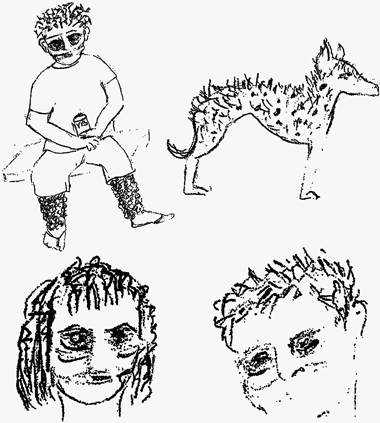Charles Bonnet syndrome (CBS) is a disorder in which psychologically normal people, often with vision impairment, experience complex visual hallucinations. The hallucinations are purely visual and do not occur in any other sensory modality, and people with CBS have full insight into the unreal nature of the hallucinations. This report describes the case of a CBS sufferer who experienced a distressing change in the nature of her visual hallucinations following a stressful event — the Black Saturday bushfires of February 2009.
A healthy and alert 80-year-old woman presented for an orthoptic consultation in September 2009. The patient was legally blind (ie, her best corrected visual acuity was less than 6/60), with diagnosed age-related macular degeneration and closed-angle glaucoma. She had a known 4-year history of Charles Bonnet syndrome (CBS), a condition that caused her to have complex visual hallucinations, usually triggered when she was in unfamiliar surroundings. She reported that the nature of her hallucinations had changed significantly.
The patient’s hallucinations became atypical on “Black Saturday”, 7 February 2009, a day of intense heat and bushfires in the southern Australian state of Victoria. Bushfires raged in 14 regions across the state, resulting in 173 deaths.1 The patient lives in an area affected by the fires and was evacuated from her home on Black Saturday. That day and subsequently, she experienced hallucinations that were horrific in nature to her, such as seeing a prickly coat on her short-haired dog, spiral wire-like hair protruding from the heads of bald family members, and their faces beginning to melt, “like wax dripping”. She saw people’s legs covered with curly, black, wiry hair. Despite her visual impairment, the patient is a talented artist and has drawn her disturbing hallucinations (Box 1).
This case demonstrates that a stressful life event can change the nature of hallucinations experienced in CBS, with an accompanying change in emotional experience (from non-distressing to distressing).
In general, hallucinations can result from false sensory input to the brain and occur in the absence of external stimuli. When a person presents with visual hallucinations, an underlying psychiatric disorder, neurological abnormality or drug intake can be suspected.2 Visual hallucinations can also occur as a result of lesions in the visual system, from the cornea to the cortex.
The occurrence of complex visual hallucinations, as reported in this case, was first described by Swiss philosopher, naturalist and lawyer Charles Bonnet in 1760, after whom the disorder was later named. CBS is characterised by vivid, elaborate and recurrent visual hallucinations in psychologically normal people, who have full insight into the unreal nature of the hallucinations.3,4 The hallucinations are purely visual and do not occur in any other sensory modality. Images of complex patterns and people are most common, and the hallucinations often fit into the surrounding situation. They can appear for several minutes every week, and can continue to occur for 12 months or more. Often CBS occurs upon waking, but not exclusively so.5 Key features of CBS are listed in Box 2.
Two theories have been proposed to explain CBS: the “release” and “sensory deprivation” theories. The release theory postulates that a lesion at any level of the visual pathway leads to the release of defective electrochemical impulses, thereby causing visual hallucinations. The sensory deprivation theory proposes a similar mechanism, except that it is reduced sensory input to the brain as a result of an ocular lesion that causes spontaneous discharge of neurones at the level of the retina or cortex.6,7
Triggers for the onset of CBS have not been clearly identified, and the circumstances the person finds themselves in at the onset of an episode can vary. It is possible that this patient suffered with acute stress disorder, as she had a past history of exposure to fire-related trauma and reported distressing recollection of the bushfires, but she did not report other symptoms of acute stress disorder.8 The change in nature of her hallucinations may represent interplay between CBS and an acute or post-traumatic stress disorder.
The number of cases of CBS in Australia is not known. Reticence to discuss symptoms of CBS out of fear of being labelled insane is common. Most people only tell a family member about their symptoms and very few discuss the problem with a medical professional.5 Further, the symptoms of CBS are probably not always recognised and therefore correctly identified.
As in this patient, CBS is usually associated with vision impairment, and it is important for clinicians to be aware that these types of hallucinations may occur in patients with advancing age and early vision impairment. The prevalence of CBS in people with impaired vision has been reported to be between 10% and 40%, with a much lower prevalence in Asian populations (< 1%).9-13 It is estimated that almost half a million Australians have vision impairment,14 and the prevalence of CBS hallucinations among these patients has been found to be 17.5%,5 suggesting that about 85 000 people in Australia may have CBS. However, while there is an association between CBS and loss of vision, it can also occur in individuals with no obvious ocular abnormality.
There is no treatment of proven effectiveness for CBS, but the use of selective serotonin reuptake inhibitors has been associated with a reduction in hallucinations.15 Sporadic reports of effective medications can be found in the literature, but no controlled clinical trials have been published. Some sufferers indicate that closing their eyes or blinking may make the hallucinations stop.5
2 Key features of Charles Bonnet syndrome
Experienced by psychologically normal people who have insight into the unreal nature of the hallucinations3
Risk factors include vision impairment, old age, hearing impairment, living alone, and female sex5
Reported prevalence is 10%–40% of the vision-impaired population; prevalence is skewed by non-reporting of the hallucinations for fear of being labelled with a psychiatric disorder5
Hallucinations typically last for several minutes and commonly occur upon waking5






None identified.